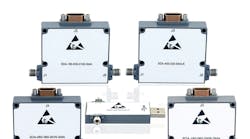Variable attenuators come in many forms, from mechanical, hand-adjusted components to digitally programmable units like those from Fairview Microwave (see "Programmable Attenuators Step 30 MHz to 40 GHz"). Such attenuators can be adjusted in level, discrete steps or by continuously variable changes.
With continuously variable mechanical attenuators, it’s possible to achieve an almost exact attenuation setting by tuning a control back and forth until a precise amplitude is reached. A step attenuator, on the other hand, will provide whatever precision is possible by the size of the attenuation steps. There is also some degree of variation in those tuning steps, measured as the repeatability of the tuning steps.
Modern programmable step attenuators such as Fairview Microwave’s components provide one performance parameter that no mechanical variable attenuator can match: attenuation tuning speed. A mechanically tuned variable attenuator may be better suited for experimental applications, in which a desired attenuation setting may be unknown. But the fast attenuation setting speeds of programmable PIN diode attenuators makes them better candidates for automated testing and any functions that must use many known attenuation values.
A mechanically tuned variable attenuator may be larger than most programmable diode attenuators, but it can also handle more power. Thus, it might be better suited for applications requiring healthy amounts of signal power, such as when performing passive intermodulation (PIM) testing. While the two types of variable attenuators are distinctly different in form and function, they also have value in different applications, which means a test bench often makes room for both.
